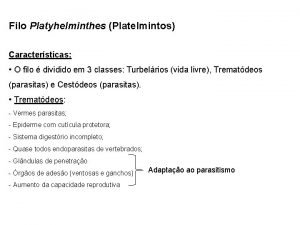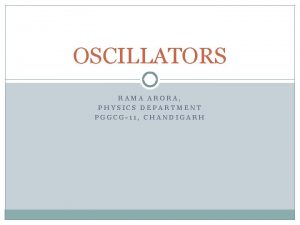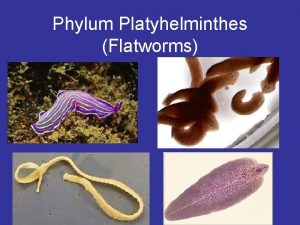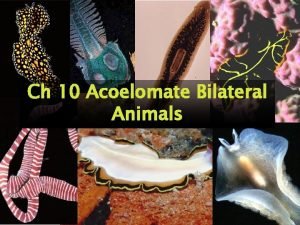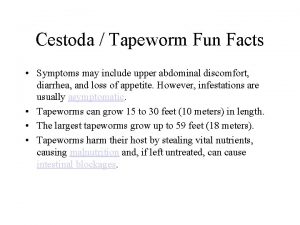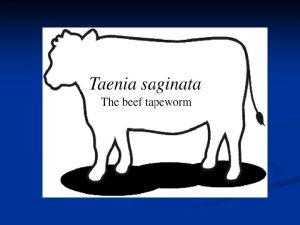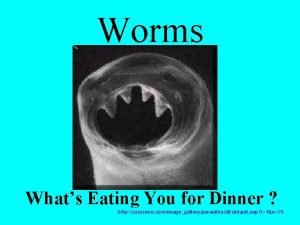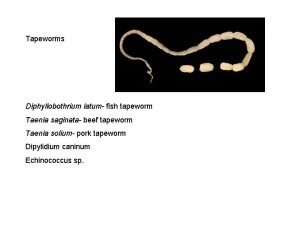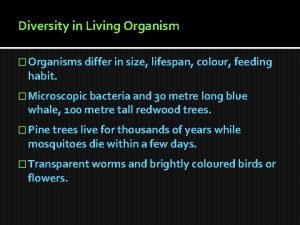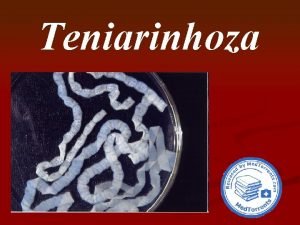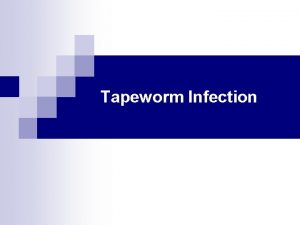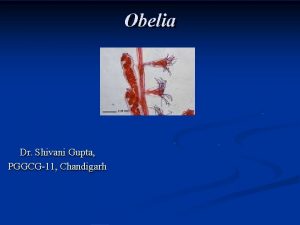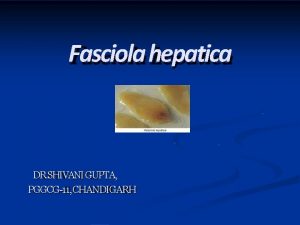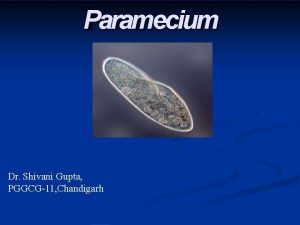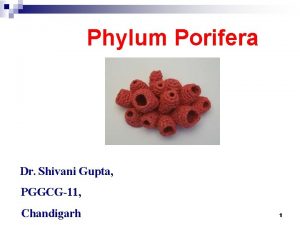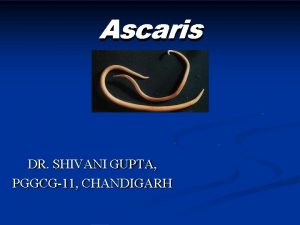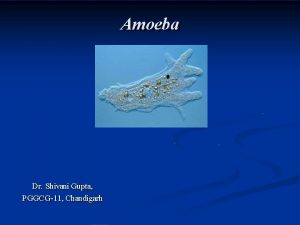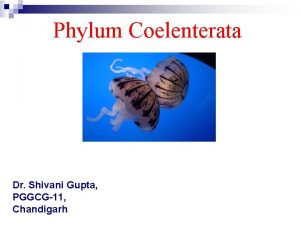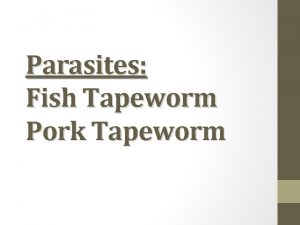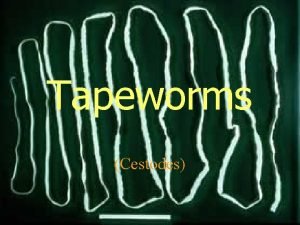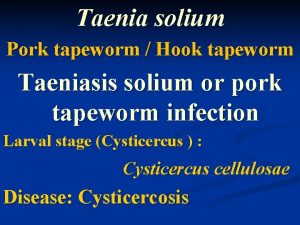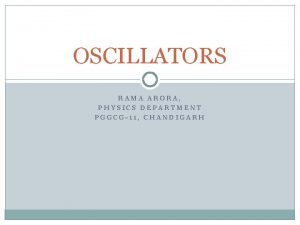Taenia Dr Shivani Gupta PGGCG11 Chandigarh Classification Tapeworm


















- Slides: 18

Taenia Dr. Shivani Gupta, PGGCG-11, Chandigarh

Classification Tapeworm infestation is the infection of the digestive tract by adult parasitic flatworms called cestodes or tapeworms. Live tapeworm larvae (coenuri) are sometimes ingested by consuming undercooked food. Once inside the digestive tract, a larva can grow into a very large adult tapeworm. Additionally, many tapeworm larvae cause symptoms in an intermediate host. For example, cysticerciosis is a disease of humans involving larval tapeworms in the human body Kingdom: Animalia Phylum: Platyhelminths Class: Cestoda Sublass: Eucestoda .

Major Attributes: Endoparasitic. Acoelomates Body is covered by tegument. Anterior end is a scolex. Body segments called proglottids. Hermaphroditic. Adult tapeworm in intestine

Morphology There are three main features to a tapeworms external morphology: the strobila (proglottids) the scolex and the tegument. 1. Strobila/Proglottids -unique among the metazoa -a linear series of sets of reproductive organs of both sexs - each is referred to as a genitalium -the area around the genitalium is a proglottid -tapeworms with mulitple proglottids are describes as being polyzoic -new proglottids are continuously differentiated near the anterior end in a process called strobilation - as each segment moves from the anterior end to the posterior end a new one takes it place -the new proglottids are produced in an undifferentiated zone between the scolex and the strobila, called the neck - this area contains stem cells which give rise to the new proglottids

Morphology -while the segments travel down the length of the worm they sexually mature, by the time they reach the end of the worm the genitalia have already copulated and produced eggs -a proglottid can mate with itself, with others in the same worm or with another worm entirely (it depends on the species of tapeworm) -a segment containing eggs is called a gravid -when the gravid reaches the end of the worm, it detaches and passes out of the host in the host feces -from here the eggs can be ingested by a new host, leading to tapeworm infection Hooks of tapeworm Mature Proglottids

Morphology Scolex and anterior strobila Mature proglottid

Morphology 2. Scolex: -The tapeworm body consists of an anterior, head-like scolex and the trunk, or strobila, consisting of a linear series of segments, or proglottids. The scolex is wider than the strobila to which it joined by a narrow neck. -The scolex attaches the worm to the gut wall of the host. For this purpose it has a retractable rostellum armed with two rings of rostellar hooks. Just posterior to the rostellum is a ring of four suckers; two dorsolateral and two ventrolateral. -Two lateral nephridial canals may be visible on each side of the scolex. They connect with each other near the rostellum via a set of convoluted scoelcial nephridial canals and extend posteriorly through the strobila.

Morphology 3. Body Wall : -The body wall consists of a syncytial, microvilliated, absorptive neodermis , a basal lamina, and layers of circular and longitudinal muscles. The nuclei of the syncytium are submerged below the basal lamina and muscle layers into the parenchyma. Inside the body wall is connective tissue consisting of the mesenchymal parenchyma in which the reproductive, excretory, and nervous systems are embedded. Tegument of tapeworm

Excretory System -The excretory system consists of numerous flame bulb protonephridia scattered throughout the parenchyma of each proglottid but they are not evident in these preparations. Individual protonephridia drain into an elaborate system of nephridial canals which ultimately open to the exterior at the posterior end of the last proglottid of the strobila. Dorsal and ventral lateral nephridial canals on each side of each proglottid extend the length of the worm. In addition to the two nephridial canals, each side possesses a longitudinal nerve cord. -The larger ventral nephridial canal is a pale, wide, longitudinal band lateral to the testes. The dorsal canal is much smaller in diameter and is located medial to the ventral canal, between it and the testis. In each proglottid the right and left ventral canals are connected by a transverse nephridial canal extending across the posterior edge of the proglottid just anterior to the junction with the next proglottid. The canals may be easier to see in immature proglottids.

Nervous System -The right and left lateral longitudinal nerve cords arise from nerve rings in the scolex and pass posteriorly in the sides of the proglottids. They are slender longitudinal lines lateral to ventral nephridial canals.

Reproductive System-Male -Most structures in the proglottid belong to the reproductive system. The male and female systems share a common genital pore (= gonopore) and genital atrium but are otherwise independent of each other. The common genital pore is a large aperture on either the right or left side of the proglottid. It opens into a shallow, cuplike genital atrium. The male and female systems both open into the atrium via its own gonoduct. -The two ducts join the medial border of the genital atrium. The anterior duct is the thicker and is the male gonoduct. The gonoduct is regionally specialized. The wide portion of the gonoduct attached to the atrium is the muscular cirrus sac. Inside the sac is the convoluted, eversible, tubular cirrus, which is the intromittent organ, or penis. During copulation the cirrus is extended from the genital pore and inserted into the genital atrium and vagina of another proglottid. -The next region of the male gonoduct is the tubular sperm duct , also convoluted, which extends to the testes. Its entire length is not visible. The testes are numerous small spheres scattered throughout the parenchyma. Each is drained by a tiny tributary of the sperm duct, but these cannot be seen. There is no seminal vesicle and autosperm are stored in the coils of the sperm duct.

Reproductive System-Female -The smaller and more posterior of the two ducts entering the genital atrium is the female gonoduct, which is also regionally specialized. The first region is the vagina. It receives the partner's cirrus and sperm during copulation. The vagina extends medially and posteriorly to the small seminal receptacle This is a clear, unstained, oval chamber where allosperm received by the vagina are stored. It is usually easily visible. A short duct exits the posterior end of the seminal receptacle and joins the oviduct. -The germarium (= ovary) is divided into large right and left lobes lying on either side of the seminal receptacle. It is the site of oogenesis and produces large numbers of small, yolkless oocytes. The two lobes of the germarium are connected across the midline by a short, wide, transverse isthmus. -The follicles of the germarium open into small ducts which drain into the isthmus. The narrow oviduct arises from the isthmus and extends posteriorly for a short distance before receiving the duct from the seminal receptacle. After receiving the duct from the seminal receptacle the oviduct continues posteriorly to the ootype. Fertilization occurs in the oviduct.

Reproductive System-Female -Yolk cells are produced by the single vitellarium at the posterior end of the proglottid. A short vitelline duct exits the vitellarium and extends anteriorly to join the oviduct at the ootype. Mehlis’s gland surrounds the ootype. -A small uterine duct, usually not discernible, extends from the ootype to the uterus. Shelled eggs move from the ootype through the uterine duct into the uterus. Within the shell meiosis is completed, a zygote forms, and development proceeds to the oncosphere larval stage. The uterus is a blind sac with lateral branches in which embryonated “eggs” are stored. The size and visibility of the uterus vary with the maturity of the proglottid. -As the proglottid ages the accumulating “eggs” cause the uterus to become larger, darker, and more visible. They will eventually fill it, distending it so it occupies the entire proglottid. There is no opening of the uterus to the exterior and eggs are released by rupture of the proglottid.

Mature Proglottid (Showing male and female reproductive system)

Fertilization and Development -Tapeworms are hermaphroditic and commonly self-fertilize, a convenience for an animal that lives in a habitat where it may be the only member of its species. Cross-fertilization may occur if more than one worm is present in the host. - Fertilization of oocytes (from the germarium) by sperm (from the seminal receptacle) occurs in the oviduct. The fertilized oocyte (with meiosis still in progress) moves posteriorly in the oviduct to the ootype where it associates with a yolk cell from the vitellarium. The role of Mehlis's gland is unclear but it may secrete a thin, delicate membrane around the yolk cells but it does not secrete the eggshell as was formerly thought. -The eggshell is the product of a joint effort by the yolk cell and the developing embryo. Shelled embryonated “eggs”, with development in progress, move anteriorly into the uterus where they accumulate and are stored. In the uterus meiosis is completed, a zygote is formed, cleavage ensues, and development advances to the oncosphere larva stage. Mature, infective “eggs” in the gravid uterus contain these larvae.

Life Cycle

Gravid Proglottid -In the gravid proglottid the uterus is vastly expanded and packed with eggs Other parts of the reproductive system are degenerate and may no longer be identifiable but the nervous and excretory systems are present and functional, although not necessarily visible. The body wall musculature remains and gravid proglottids are mobile and very active. -The uterus, filled with small spherical “eggs”, fills all available space. Its lateral uterine lobes are much larger now and so numerous they crowd against each other, filling most of the interior. They are bounded laterally by the ventral nephridial canals. -The genital pore, genital atrium, sperm duct, and vagina are present but no longer functional. Remnants of other parts of the reproductive system may be visible also. Gravid Proglottid

Life Cycle
 Pggcg11
Pggcg11 Filo platelmintos classes
Filo platelmintos classes Series fed hartley oscillator
Series fed hartley oscillator Maha shivani
Maha shivani Shivani baisiwala
Shivani baisiwala Semiconductor complex chandigarh
Semiconductor complex chandigarh Solarchandigarh
Solarchandigarh Distingration
Distingration Biology relationships
Biology relationships Flatworms symmetry
Flatworms symmetry Hymenolepis nana diagnosis
Hymenolepis nana diagnosis Acoelomate bilateral animals
Acoelomate bilateral animals Tapeworm fun facts
Tapeworm fun facts Hookless tapeworm
Hookless tapeworm Curezone parasites
Curezone parasites Tapeworm
Tapeworm Living organisms differ in
Living organisms differ in Taenia saginata phylum
Taenia saginata phylum Tapeworm adults
Tapeworm adults

